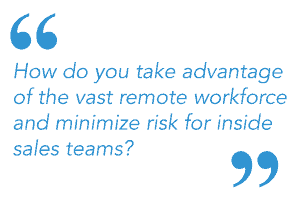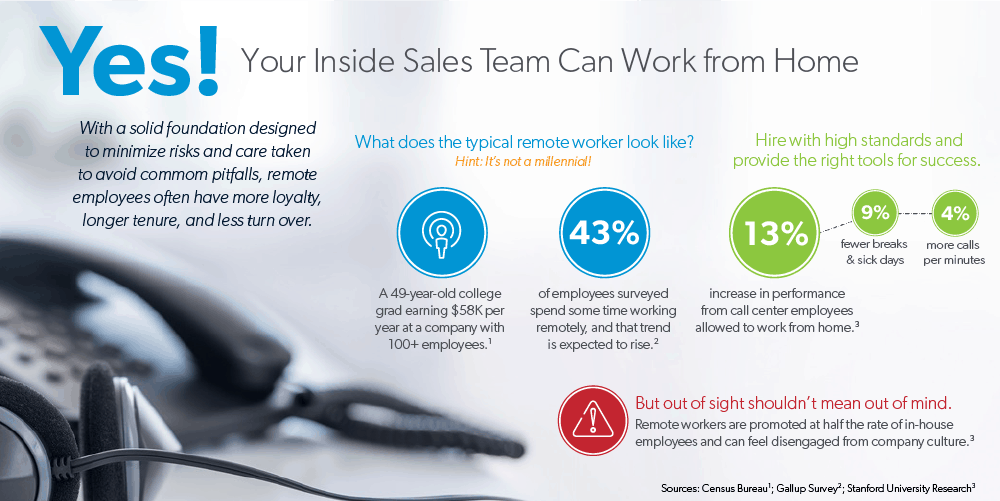Imagine you have a valuable employee who has exceeded expectations for several years. She’s a single mom with a child who has healthcare challenges. The employee commutes to your office headquarters, spending a couple of hours in the car every day. Her child requires several visits to the doctor during the day, as well as being monitored for emergencies. Can you imagine the stress on that employee? Yet, her productivity to your organization is difficult to replace. What do you do?
A Gallup survey on employee engagement found that 43% of employees surveyed spend some amount of time working remotely, and that trend is expected to rise. Gallup also found that flexible scheduling and work-from-home opportunities play a major role in an employee’s decision to take or leave a job.
A research study by Stanford University found that employees at a call center who were allowed to work from home led to a 13% performance increase, of which, 9% was from working more minutes per shift (fewer breaks and sick days) and 4% from more calls per minute (attributed to a quieter and more convenient working environment). Replacing commute time with actual work activities alone increases production.
While millennials (now the largest generation in the workforce) appreciate and look for work-from-home opportunities, recent research from the Census Bureau revealed the typical remote worker is actually a 49-year-old college grad earning $58,000 per year, working for a company with 100 or more employees. And with unemployment rates at 4.4%, you may find a need to expand your talent pool beyond the local community, and there are cost advantages to offering salaries that are aligned with lower-cost-of-living markets. You can take advantage of attracting the younger workforce and stay-at-home parents or find valuable experienced salespeople who are retired but still looking for income opportunities. Much of this research is showing that remote employees have more loyalty, longer tenure, and less turnover.
 So, why are we seeing companies like Yahoo and IBM pulling their remote workers back inside the office? This is where it gets tricky; there are challenges to consider when allowing your employees to work from home. The aforementioned research from Stanford University found that remote workers are promoted at half the rate of in-house employees, and almost half of those in the study actually chose to return to the office when given the choice to work from home or in the office. Remote employees can feel disengaged from the company culture, and if not managed correctly, can miss collaboration opportunities from teammates.
So, why are we seeing companies like Yahoo and IBM pulling their remote workers back inside the office? This is where it gets tricky; there are challenges to consider when allowing your employees to work from home. The aforementioned research from Stanford University found that remote workers are promoted at half the rate of in-house employees, and almost half of those in the study actually chose to return to the office when given the choice to work from home or in the office. Remote employees can feel disengaged from the company culture, and if not managed correctly, can miss collaboration opportunities from teammates.
In the sales world, managing remote workers is not a new concept. Where do you think the field representatives work? However, managing inside sales teams that almost entirely work on phones is a newer trend. How do you take advantage of the vast remote workforce and minimize risk for inside sales teams?
We asked Karen Doherty, Senior Inside Sales Manager for our technology partner Jabra, what she has learned by managing a team that includes a significant portion who work from home. (Jabra creates the world’s highest quality headsets for inside sales or customer service departments.) Karen explained the secret to managing remote inside sales reps is having high standards in the hiring process and providing the right tools to help them be efficient and effective in their jobs. She said you also have to provide managers with the proper software to monitor the reps’ progress and performance.
She searches for people who have experience striving toward specific metrics—those measured by talk time, exceeding sales quotas, having experience with inside and outside sales, and who have participated in sales training programs. Jabra also puts its remote sales reps in key markets that are home to some of their largest accounts. That way, if a large account requires a face-to-face meeting, the inside sales rep can easily visit the customer in person. Karen said this equates to approximately 10% to 20% of their time.
The Technology Factor
When it comes to how technology plays a part, it begins with having a well-developed customer relationship management (CRM) system. Does your CRM system determine the sales process or does your sales process build the CRM system? At MarketSource, we begin with building an engineered sales process and then develop our Salesforce.com instance according to the buyer’s journey and the stage-by-stage process map. Consequently, inside sales reps aren’t merely entering the last conversation they had; they are using an entire playbook for next steps.
However, there’s more technology available than just a CRM system.
Use a cloud-based telephony PBX solution, which allows your representatives to log in to a CRM-integrated phone system from anywhere. With this tool, managers can see when the sales reps are available, on the phone, or unavailable. They can also measure average talk time, contact rates, and daily activity.
Using a robust, CRM-integrated, phone observation and speech analytics technology (like ExecVision), a manager can listen to calls in real-time or recorded, see the percentage of listening versus talking the rep is doing, type in keywords that jump to important sections of the call versus listening to the entire conversation, and share notes back and forth with the sales rep.
To help keep your team engaged, collaborative, and part of the culture, utilizing a tool like Skype for Business or Google Hangouts for your team meetings allows for a more personal experience during a team conference call. Instant messaging is also a quick way to collaborate and replaces the cubicle visit, which can be disruptive.

Communication Is Key
Open communication is critical to managing any inside sales team but is particularly important for remote employees.
- Have new hires visit the home office during their first week on the job for training.
- Schedule and follow through with one-on-one meetings.
- Learn your rep’s communication preferences. Some people respond better to impromptu phone calls, while others prefer text, email, or instant messenger.
- Find time for the team to get together quarterly.
Don’t Forget the Basics
- Be sure your reps have the appropriate high-speed Internet access, a quiet dedicated workspace with a door, and a laptop with higher processor speeds.
- Establish key performance indicators, standards, goals, and metrics to hold them accountable for results.
- Create a daily, hour-by-hour schedule to help organize your reps’ time and remove the guesswork from their job.
The Rest of the Story
By the way, the single mom set up a home office, which allowed her to take care of her child and continue growing revenue for her employer. By permitting her to work from home, the employer reenergized a key employee, avoided disruption, and gained her loyalty through gratitude.
Let Us Help
Are you considering remote inside sales opportunities to expand your talent pool and reduce turnover? At MarketSource, we have more than 140 recruiters who find the right talent, business process engineers to design the right sales model, a technology stack to maximize sales efficiency, and experienced sales managers who coach and develop inside sales professionals. We can help you beat your revenue targets. Contact us today for a MarketSource assessment.

